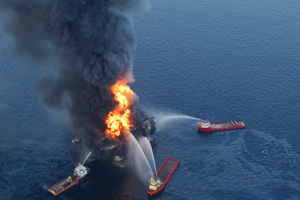Today is the 22nd anniversary of the Exxon Valdez oil spill in Alaska’s Prince William Sound, which until last summer’s BP disaster was the worst oil spill in US history. And to mark it, this week we have another oil slick in the Gulf of Mexico.
The slick reportedly stretched for 30 miles, with oil washing ashore along Louisiana’s Grand Isle. When it was reported earlier this week in the Times-Picayune, officials were puzzled about the source. Then on Tuesday night, the responsible party ‘fessed up. From The Lookout:
Anglo-Suisse Offshore Partners issued a statement last night expressing “surprise” that what it claimed was a minor leak from a well that’s been out of use for some time could have produced miles-long slicks that garnered national media attention. The company has been in the process of permanently plugging the well — located in a shallow area about 30 miles southeast of Grand Isle, La. Anglo-Suisse owned a cluster of five platforms in that area that were destroyed by Hurricane Katrina in 2005.
The Times-Picayune reported that the company said it only leaked 5 gallons of oil. But as The Lookout’s Brett Michael Dykes points out, that’s more than a little questionable given the size of the slick and the amount of oil people were reportedly finding on the beaches.
Of course, the oil was “nowhere near the volume of Deepwater Horizon but still significant enough,” as Coast Guard Rear Adm. Mary Landry said earlier this week (via the Wall Street Journal). But it was a good reminder of something that we reported on last year in the middle of the BP spill, when evidence of additional leaks nearby came to light. Even when there’s not a massive spill underway, there may we be leakage from other wells that isn’t monitored very closely. Companies are required by law to report their spills to the National Response Center, Coast Guard or Environmental Protection Agency if there’s a “visible sheen,” but that requires them to notice the leak, actually report it, and be honest about how much oil has spilled.















